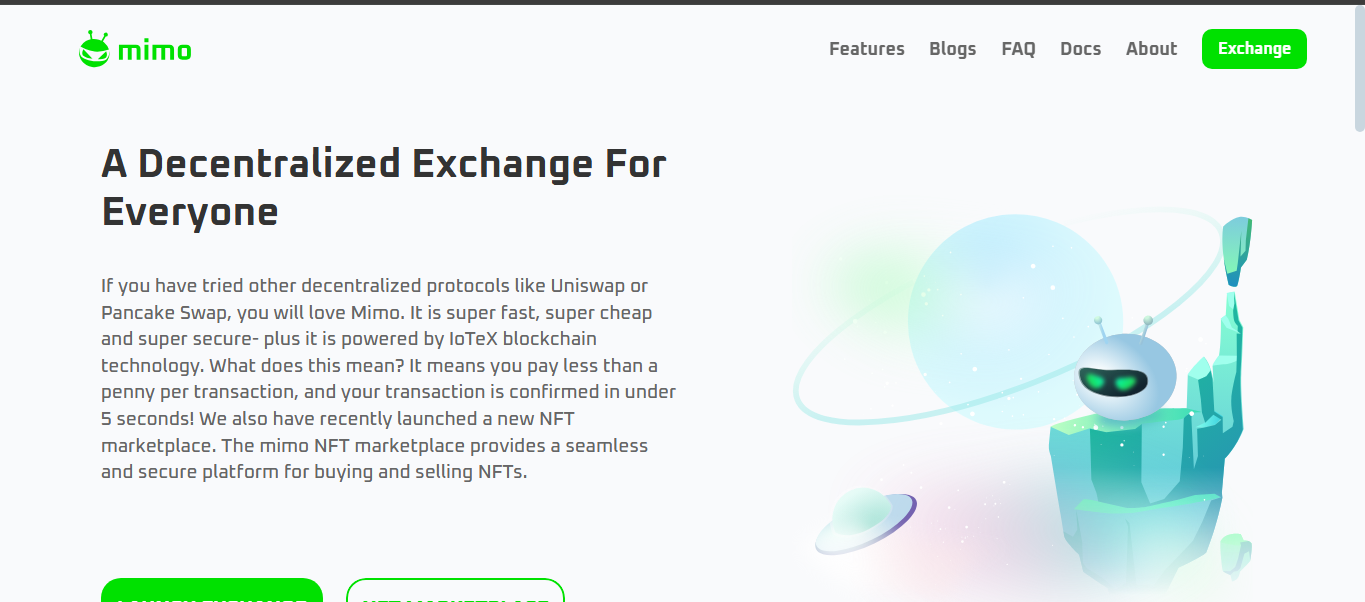Mimo Exchange - lending-first DeFi hub with yield focus and niche appeal

Mimo Exchange launched on Ethereum in 2021, aiming to combine over-collateralized lending, passive savings and on-chain swapping - all governed by native token holders. It targets savers and lenders seeking stable yields rather than active traders. But as traditional DeFi challengers emerge, questions remain whether Mimo can keep pace in volume, safety and utility.
A different DeFi orientation
Mimo isn’t just another AMM or DEX - it’s a lending mechanism built around its MIMO token. Core idea: users deposit supported collateral (like stablecoins or ETH) to borrow yield-bearing synthetic assets called USDn, MAssets or colDAI. Repay later and earn interest or rewards. This ecosystem refocuses DeFi around utility and cash flow rather than speculative swapping.
Key components:
- Lock in collateral, mint synthetic token
- Generate yield via protocol interest or external yield earners
- Governance by MIMO token holders deciding on risk factors, collateral, fees
It’s a governance-powered machine where users choose risk exposure and reward parameters.
How active is the system?
On-chain stats show about 30 to 50 million dollars in total value locked (TVL) - modest in the DeFi sphere. Daily yield and lending volumes range from 1 to 5 million dollars. Savers seem active, but relative to giants like Aave or Compound, Mimo is a boutique operation.
Borrowers tend to be yield-focused and stablecoin-native, not traders chasing leverage. That narrows appeal - if you want swapping volume or aggressive margin plays, Mimo won’t satisfy.
Yield mechanics and token incentives
Mimo rewards revolve around protocol interest and MIMO token staking:
- Synthetic tokens earn lending protocol interest, plus occasional extra yields
- Borrow USDn and stake MIMO to farm extra tokens based on tiered APY
- MIMO stakers get fee cuts, governance voice, and share protocol revenue
Incentives keep yields stable - but distribution trends suggest early farmers benefited most. Retention strategy relies on yield sustainability and staking demand.
Tokenomics and MIMO dynamics
MIMO has a capped supply of around 100 million, with much initially allocated to community incentives, early backers and the foundation. Circulation rotates as users stake and earn. Token price fluctuates between 1.00 and 3.00 dollars, often in line with broader DeFi movements.
Strong point: MIMO is useful for protocol access and yield. Weak point: token relies heavily on continued use and mint-repay cycles - not speculative hype or massive swap volumes.
Security, audits and transparency
Mimo has gone through multiple smart contract audits in 2021 and 2022, with reports publicly available. No major exploits have been reported to date. There’s a bug bounty program, though payouts are modest. Contracts are open-source and community-reviewed. On the transparency front, collateral ratios, liquidations and mint history are all visible on-chain, supporting trust.
That said, as a lending protocol it carries liquidation risk - rapid price swings could trigger auto-liquidations. So users must stay vigilant on collateral health and market forces.
User experience and education
All activity takes place via web3 wallet (MetaMask etc.). Dashboard is clean, but beyond basic minting and staking functions, there’s minimal hand-holding. There are guides and forum posts but no deep educational platform. For experienced DeFi users, this is fine. Beginners might struggle without clear tutorials or step-by-step walkthroughs.
Customer support is community-driven via Discord and Telegram. Response quality varies - some users report quick fixes, others describe delays.
Pros & cons at a glance
Feedback across forums and reviews is diverse:
Pros
- Yield-first lending model with synthetic assets offers utility-based DeFi
- Open-source contracts, multiple audits, bug bounty programs
- MIMO token integrates staking, governance and fee rewards
- Full on-chain operations provide transparency and control
Cons
- Relatively low TVL and limited adoption compared to larger DeFi platforms
- User experience is tech-centric, with less guidance for newcomers
- Liquidation risk during volatile price events puts collateral at stake
- Token dynamics tied to sustained minting and staking demand
How it compares to peers
Compared with Aave or Compound, Mimo’s TVL is smaller and focused on stablecoins and synths. It lacks flash-loan support, or variable-rate pools, which limits flexibility. But it compensates with deeper synthetic asset functionality and integrated yield farming via MIMO.
Compared to Curve or Yearn, it trades volume and interoperability for targeted yield design. Mimo isn’t a multi-strategy aggregator - it’s a lending specialist.
Final verdict - focused utility, but niche stay
Mimo Exchange is not trying to be a full DeFi ecosystem clone - it’s a lending and synthetic yield specialist. For users seeking predictable, collateral-backed borrowing and interest with transparent token rewards, it hits the mark. If the TVL and yield growth continues, it could grow meaningfully in the savings-savvy DeFi niche.
But if your goals include high-volume swapping, margin use or large speculative plays, larger platforms outperform. Use Mimo carefully, manage collateral risk and keep in touch with community channels when yield data shifts.
Disclaimer
“This content is for informational purposes only and does not constitute financial advice. Please do your own research before investing.”
.png)







%203.svg)
%203.svg)




















